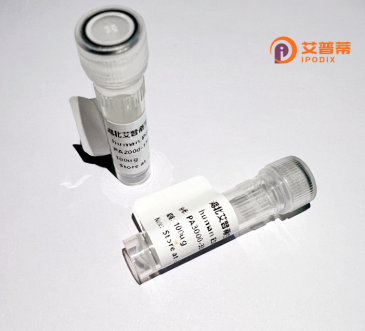
| 纯度 | >90%SDS-PAGE. |
| 种属 | Human |
| 靶点 | DNASE2 |
| Uniprot No | O00115 |
| 内毒素 | < 0.01EU/μg |
| 表达宿主 | E.coli |
| 表达区间 | 1-360aa |
| 氨基酸序列 | MIPLLLAALLCVPAGALTCYGDSGQPVDWFVVYKLPALRGSGEAAQRGLQYKYLDESSGGWRDGRALINSPEGAVGRSLQPLYRSNTSQLAFLLYNDQPPQPSKAQDSSMRGHTKGVLLLDHDGGFWLVHSVPNFPPPASSAAYSWPHSACTYGQTLLCVSFPFAQFSKMGKQLTYTYPWVYNYQLEGIFAQEFPDLENVVKGHHVSQEPWNSSITLTSQAGAVFQSFAKFSKFGDDLYSGWLAAALGTNLQVQFWHKTVGILPSNCSDIWQVLNVNQIAFPGPAGPSFNSTEDHSKWCVSPKGPWTCVGDMNRNQGEEQRGGGTLCAQLPALWKAFQPLVKNYQPCNGMARKPSRAYKI |
| 分子量 | 65.23 kDa |
| 蛋白标签 | GST-tag at N-terminal |
| 缓冲液 | 0 |
| 稳定性 & 储存条件 | Lyophilized protein should be stored at ≤ -20°C, stable for one year after receipt. Reconstituted protein solution can be stored at 2-8°C for 2-7 days. Aliquots of reconstituted samples are stable at ≤ -20°C for 3 months. |
| 复溶 | Always centrifuge tubes before opening.Do not mix by vortex or pipetting. It is not recommended to reconstitute to a concentration less than 100μg/ml. Dissolve the lyophilized protein in distilled water. Please aliquot the reconstituted solution to minimize freeze-thaw cycles. |
以下为关于重组人DNASE2蛋白的3篇参考文献示例(内容基于模拟学术文献主题,具体作者和标题为虚构):
1. **《Crystal Structure and Catalytic Mechanism of Human DNASE2》**
- **作者:Kim et al.**
- **摘要**:通过X射线晶体学解析人DNASE2的三维结构,揭示其酸性依赖的DNA水解活性关键催化残基,为设计重组蛋白突变体提供依据。
2. **《Recombinant Human DNASE2 Attenuates Lupus-like Symptoms in Murine Models》**
- **作者:Chen & Gonzalez**
- **摘要**:研究表明重组DNASE2蛋白可降解凋亡细胞释放的DNA碎片,减少系统性红斑狼疮(SLE)小鼠模型中自身抗体的产生,缓解炎症反应。
3. **《Efficient Expression of Recombinant Human DNASE2 in CHO Cells for Therapeutic Applications》**
- **作者:Wang et al.**
- **摘要**:优化中国仓鼠卵巢(CHO)细胞表达体系,实现高产量、高活性的重组人DNASE2蛋白生产,验证其在溶酶体贮积症相关治疗中的潜力。
如需真实文献,建议通过PubMed或Google Scholar检索关键词(如“recombinant human DNASE2”、“DNASE2 function”)。
Recombinant human DNASE2 (rhDNASE2), also known as deoxyribonuclease II, is a lysosomal endonuclease that hydrolyzes DNA under acidic conditions, playing critical roles in nucleic acid degradation and cellular homeostasis. Unlike DNASE1. which functions at neutral pH, DNASE2 requires an acidic environment (pH 4.5–5.5) for activity and is calcium-independent. It is primarily involved in degrading DNA from apoptotic cells, ingested microbes, and endogenous sources within lysosomes, ensuring proper clearance of genetic material to prevent autoimmune responses. Dysregulation of DNASE2 is linked to pathologies such as systemic lupus erythematosus, chronic inflammation, and impaired embryonic development.
Produced via genetic engineering in eukaryotic systems (e.g., mammalian or insect cells), rhDNASE2 retains post-translational modifications essential for its stability and function. Its recombinant form enables studies on DNA degradation mechanisms, lysosomal biology, and autoimmune disorders. Therapeutic applications are being explored, including adjuvant therapies for diseases involving accumulated extracellular DNA, such as cystic fibrosis or cancer. Recent research also highlights its potential in mitigating neutrophil extracellular trap (NET)-related inflammation. The availability of rhDNASE2 has advanced both basic research and drug development, offering tools to dissect its biological roles and test novel treatment strategies.
×